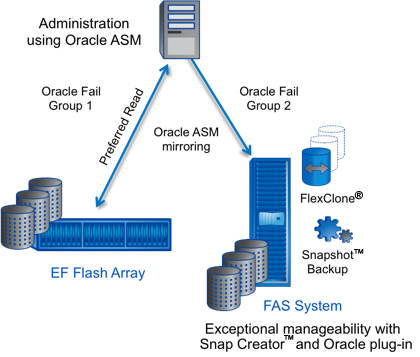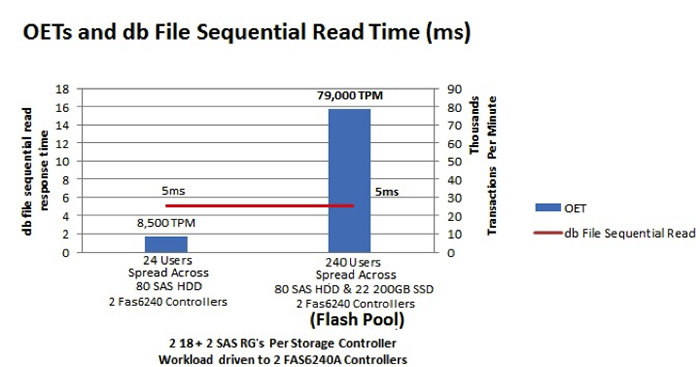


At Oracle OpenWorld in September, NetApp saw great traction for our your data, any cloud approach, which makes it easier to move and use data in both private and public clouds. The FlexPod® data center platform continues to grab a lot of attention as momentum there builds. A recent Tech OnTap article describes recent FlexPod enhancements, including Cisco® Validated Designs for Oracle® configurations.
DBAs and line-of-business managers are also beginning to recognize that clustered Data ONTAP® can be a game changer. When you provision database storage for peak load, much of the time your expensive storage infrastructure may be relatively idle. With clustered Data ONTAP, you can easily move data between storage tiers to adapt to changes in demand and get the most from your investment in high-performance storage and flash.
A large oil and gas company plans to use this approach to support the SAP® check-writing module. When it's time to cut checks, they will move the required data—transparent to the application—to flash-accelerated media. When the process is complete, they'll move it back. Because the data no longer needs to be on fast storage all the time, it's more economical. Acceleration can be used when it's needed for particular datasets.
This year, three themes really resonated with people:
- Accelerating Oracle with flash
- Reducing RTO/RPO through automation and efficiency
- Increasing business agility with thin clones
I want to spend some time explaining each of these in a bit more detail.
Integrating Flash into Your Oracle Environment

Naturally, everyone is talking about flash and what it can do for database performance. But at the same time, it's pretty clear that in the database world, most people aren't interested in science experiments that haven't been fully proven.
I think that's why NetApp® flash technology is resonating. The technology used in our EF-Series flash arrays is built on a legacy of more than 650,000 deployed storage systems, so it delivers proven performance, reliability, availability, and manageability.
NetApp has three different flash solutions to address Oracle's needs:
- All-flash (possibly paired with FAS)
- Hybrid using Flash Pool™ intelligent caching
- Hybrid using Flash Cache™ intelligent caching
All-Flash Array Plus FAS
The first solution combines the capabilities of Oracle with the performance of the NetApp EF540 or EF550 flash array and the data protection capabilities of NetApp FAS. It uses Oracle Automatic Storage Management (ASM) to split the data and send all writes simultaneously to the EF array and the FAS array. Because of its proven write architecture, which logs incoming writes to NVRAM and then performs full-stripe writes to spinning, the FAS array is capable of handling high-write workloads, even without flash acceleration.

Figure 1) Using a combination of EF for submillisecond latency and high transactional performance and FAS for redundancy and data management gives you the best of both platforms.
The EF array is the preferred path for reads, while the FAS array provides redundancy and data protection features. This solution is documented more fully in TR-4145.
To a DBA, of course, having two data paths could look a little like a "science experiment." That's why NetApp has collaborated with AppDynamics, which does deep triage from the application down to the storage infrastructure. If there's a performance bottleneck, this tool can identify and solve it quickly. The AppDynamics product works with both Data ONTAP and SANtricity® running on EF arrays, so you can look at performance over both data paths at once or each data path separately. This helps you to deliver performance and manageability and to reduce risk.
Flash Pool
NetApp Flash Pool technology delivers predictable performance for very specific Oracle workloads without requiring an investment in an all-flash array. Use of Flash Pool in Oracle environments is documented in TR-4195.
This report looks at the effect of adding a relatively small amount of flash (1% to 12% of total HDD capacity) on OLTP performance. Adding SSDs to create a Flash Pool cache in combination with 80-15K drives nearly tripled throughput as measured in transactions per minute, while reducing latency to less than a third of the unaccelerated workload. If you compare throughput achievable at the same latency between disks alone and Flash Pool (disks plus SSDs), throughput increases by 9X.

Figure 2) Adding SSDs to create a Flash Pool cache from an existing disk configuration increases throughput by 9X.
A similar test using 108-3TB SATA drives combined with 11-200GB SSDs increased throughput by almost 2.5X and again reduced latency by two-thirds.
Flash Pool technology provides:
- Persistent, fast read-response times for large, active datasets
- Increased system throughput
- Potential reduction in the number of HDDs, as well as the ability to use lower-cost capacity HDDs in place of performance HDDs
Flash Cache
Many Oracle on NetApp customers have been running Flash Cache software since it was first released in 2009. Flash Cache is implemented as a PCIe flash card installed directly in FAS controllers, providing an accelerated read cache many terabytes in size. (The current maximum is 16TB for the FAS6290 using multiple cards.) All of our FlexPod solutions that involve Oracle include Flash Cache, and any Oracle workload that is read-heavy can benefit from this technology. Tests show that adding Flash Cache to an existing HDD-only configuration can increase I/O throughput by 75% and average response time by 30%.
Additional guidance for using Flash Cache and Flash Pool with Oracle databases can be found in TR-4162.
Backup and Recovery

I know that Tech OnTap® has covered Oracle backup and recovery in past articles, but it remains a major concern for DBAs and is an area where NetApp, and NetApp Snapshot™ technology, make a big difference.
How big? We ran tests on an 8TB database using the Oracle Automated Stress Test (OAST) schema, an Oracle-supplied test tool and schema. Using RMAN, the traditional Oracle backup tool, the backup took 26 hours using binary compression. By comparison, a consistent NetApp Snapshot backup using SnapManager® for Oracle—which puts the database in hot backup mode, performs the Snapshot copy, and then resumes normal database operation—took just 1 minute and 47 seconds. Check out the "Test Environment" and "Results and Conclusions" sections of the Oracle on FlexPod CVD for more information.
That's fast, and there's also a significant side benefit. Oracle RMAN runs on the server. You buy Oracle licenses for the number of cores you need to run your application—including the compute horsepower you need to do backup. Offloading that work from server to storage means that your application can run as well or better with fewer Oracle licenses. In practice, people don't typically return licenses, but this does free up Oracle resources for other things such as dev/test.
At this point, you may be thinking, "But every storage vendor has snapshot technology. Why would I choose NetApp over some other storage?" Other vendors' snapshot technology is based on copy-on-write. Every time a block is overwritten, the original block must first be copied elsewhere. That reduces the speed with which data can be written, slowing the database down. NetApp WAFL® (Write Anywhere File Layout) never overwrites existing blocks, so there's no copy-on-write and no performance penalty. You can keep up to 252 Snapshot copies per volume with negligible performance impact. Storage space is consumed only when changes are made to the active database.
Another objection that I hear is that Snapshot copies aren't "real" backups because a "real" backup allows you to recover from an infrastructure or site-wide failure event. That's why, when you create a Snapshot copy on NetApp storage, we provide the means to mirror or vault that copy to secondary and tertiary remote locations as needed. Again, the work is performed by the storage system and the database server is not impeded. Once you have a consistent Snapshot copy—which takes less than 2 minutes, so you can do it as often as you need to—we give you lots of data protection and data management options.
A final issue is that many Oracle DBAs know their existing tools and hesitate to change the way they do business. Several years ago, NetApp built an interface for RMAN that allows you to run NetApp Snapshot backups, NetApp SnapRestore® (for restoring Snapshot backups), and NetApp FlexClone® (more on that in the next section) from the tool you're already accustomed to, reducing risk and simplifying adoption.
Increasing Business Agility with Thin Clones

The final technology I want to talk about is cloning by using NetApp FlexClone technology. FlexClone lets you create a writable "copy" of a volume, while using only incremental storage—hence "thin clones." Check out Back to Basics: FlexClone if you're not familiar with this NetApp technology.
From the standpoint of Oracle, the advantage of FlexClone is that you can have a writable copy of a database whenever you need one. How you perceive the advantages of FlexClone may depend on what your role is:
- Storage administrators appreciate FlexClone because its efficiency reduces the total storage footprint. You no longer have to scramble to find free disk space when a database copy is needed.
- DBAs appreciate FlexClone because it reduces risk. When it's time to install a patch on your production instance, you can create a clone, install the patch there, and make sure that everything works as expected before rolling it out.
- Line-of-business people like FlexClone because everyone on the development team can have their own clone, so development proceeds more quickly.
Simplifying the Application-Testing Flow
Testing applications—whether for a new or an existing database release—is always a complicated, time-consuming, and potentially expensive process:
- To be certain that your applications work correctly, you have to test with production data, and you might need many copies of that production data to make sure that testing doesn't cause a bottleneck.
- Because you're using real data from your production database, you probably also need to protect sensitive information such as names, addresses, account information, credit card information, and so on.
- You need a testing methodology that really tests your application against your test database.
You can streamline the process of application testing on Oracle 11g by using a combination of capabilities from NetApp and Oracle:
- NetApp FlexClone technology lets you make as many thin clones of a data set as you need.
- The Oracle Data Masking Pack provides regulatory compliance through consistent and rule-based application of masking formats. A rich and extensible format library supports a variety of mask formats.
- NetApp SnapManager for Oracle automates cloning, data masking, and other processes for maximum efficiency, while reducing the chance of operator error.
- Oracle Real Application Testing, introduced in Oracle Database 11g, in conjunction with NetApp technology, makes it possible to quickly test applications to make sure that they are functioning and performing correctly.
Figure 3 illustrates the process flow for testing by using these technologies.

Figure 3) Process flow for creating test environments and testing by using a combination of NetApp and Oracle technologies.
Conclusion

NetApp continues to release new innovations to enhance Oracle database operations. A variety of flash solutions allow you to choose an option that meets your performance needs without breaking your budget. Snapshot and cloning technologies, although not new, simplify and accelerate a variety of data management tasks, and DBAs are still discovering their value.
Recently released FlexPod CVDs make it easy to deploy new applications with the right infrastructure, and clustered Data ONTAP offers a host of new capabilities that can make your Oracle environment even more flexible.





